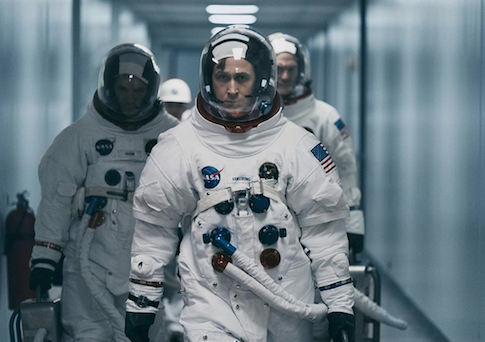I get the sense there are two things Damien Chazelle hoped to accomplish with First Man.
The first thing is to cinematically approximate what it's like to be locked in a tiny can strapped on top of a series of enormous bombs as you hurtle into the least hospitable environment humans can hope to endure.
You get a sense of this (minus the bombs) in the film's opening moments, as Neil Armstrong (Ryan Gosling) flies an experimental jet through the Earth's atmosphere. Before he can see the curve of the Earth—and the blackness of space beyond—he, and we, must endure the journey up and out. Chazelle's camera shakes, has difficulty focusing on the switches and lights and buttons as we speed through mach two, three, four. The soundtrack overwhelms, rattling, shaking; it feels as though the theater itself is going to fly apart.
And then he's through! The view: spectacular. The sound: muted. Getting back to Earth is a problem of its own: Armstrong "bounces off the atmosphere," and, lacking friction in the air to make normal piloting maneuvers, it's only his quick-thinking and steely nerves that keep him from floating off into the nothingness of space, forever.
There are several scenes like this, efforts to approach the inherent terror and exhilaration of exploration for schlubs such as us who are never going to slip the surly bonds. Armstrong on top of a Gemini rocket, propulsive blasts beneath him blowing up, the bass in the IMAX sound system practically concussing viewers with literal waves of sound. Gus Grissom (Shea Whigham), Ed White (Jason Clarke), and Roger Chaffee (Cory Michael Smith) shoved into a cramped command module, trying to figure out why the radio wasn't working, as a spark turns the whole thing into an inescapable inferno. Armstrong and Dave Scott (Christopher Abbott) fighting against centrifugal force and staving off a blackout during an unexpectedly turbulent docking test.
But why go to the moon at all? This is the second thing Chazelle hopes to explain. It's a question Armstrong answers by highlighting the need to expand our horizons, to see what's out there, to see the world we can create for our children and our children's children. And when Armstrong opens the Apollo hatch and sees the surface of the moon, our horizons literally expand, at least if you're watching in IMAX: the film, heretofore presented in anamorphic widescreen (2.39:1), expands to the full IMAX frame, 1.43:1. The film stock itself takes on an enhanced brightness and clarity: gone is the grain from the previously shaky picture; removed is the occasional inability to focus. Everything on the moon is vivid and sharp.
Chazelle is by no means the first to pull this trick—I seem to remember the second Hunger Games film doing something similar when the teenaged combatants ascended into their beach battlezone. But the effect is still breathtaking. It serves as a reminder of the peevishness of the politicians more concerned with pinching pennies than achieving greatness, a rejoinder to the childishness of the protesters chanting about sending "the white man" to the moon while we still have troubles to take care of at home.
Chazelle combines this technological jolt with an emotional one that I won't get into here so as not to spoil it. All I'll say is that its power, combined with the somewhat impressionistic way Chazelle chooses to depict Armstrong's moments on the moon's surface, renders silly much of the faux-controversy surrounding the fight over First Man's depiction of the American flag's placement on the moon.
IMAX's superior technical possibilities are often used for spectacle, and that's fine. But Chazelle has done something more important with the large format: He's made a thematic point, using the power of the movies to drive home the power of human ingenuity and the preciousness of human connection. If you're going to see First Man—and I think you should—you have to see it this way, in this format. Otherwise you can barely be said to have seen it at all.
